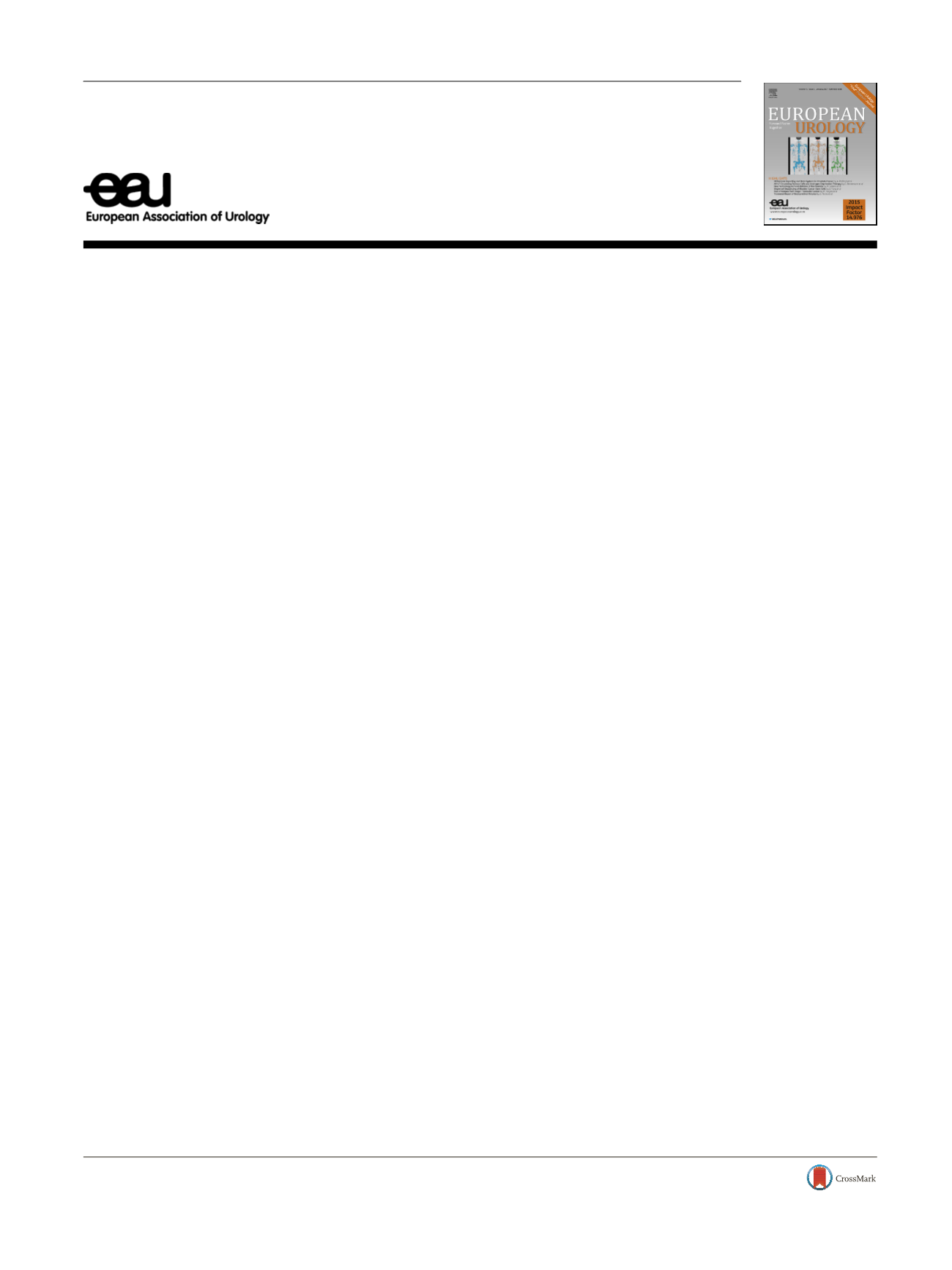

Letter to the Editor
Re: Jaimin R. Bhatt, Patrick O. Richard, Nicole S. Kim,
et al. Natural History of Renal Angiomyolipoma (AML):
Most Patients with Large AMLs >4 cm Can Be Offered
Active Surveillance as an Initial Management Strategy.
Eur Urol 2016;70:85–90
We read with great interest the article by Bhatt et al
[1]. The
study included 447 patients with 582 tumors, with a
median follow-up period of 43.2 mo, to measure the natural
growth rates of renal angiomyolipoma (AML) using a
unique radiology data-mining system filtering a total of
2741 patients with probable renal AML. Bhatt and
colleagues
[1]found that most sporadic AMLs are asymp-
tomatic and do not grow or grow slowly, regardless of the
initial size (
>
4 cm or 4 cm). Based on their experience the
authors suggest a policy of initial active surveillance for all
asymptomatic AMLs, even if they are
>
4 cm. The conclusion
may challenge the current management strategy of renal
AML
[2] .We noticed that the vast majority of lesions were small,
with the median size being 1 cm; however, the size was
significantly larger for tuberous sclerosis complex (TSC).
The author stated that patients who underwent abdominal
imaging (computed tomography [CT] or ultrasound) were
included. However, even CT is not accurate for small AMLs,
especially for AMLs 1.3 cm
[3], which may lead to
measurement errors in the follow-up. Regarding the data
for the same patients who underwent the same abdominal
imaging each visit, the diameter of AML detected by CT or
ultrasound may be different even at the same follow-up
time. In addition, we want to know if there were any
patients detected using magnetic resonance imaging (MRI),
or if the authors excluded the data regarding those who
underwent MRI. MRI is essentially equivalent in terms of
accuracy to CT in the diagnosis of AML and can be
particularly helpful in diagnosing fat poor AMLs
[4], and
is also widely used for the diagnosis of AML in clinical
settings.
We definitely agree with the opinion of Ribal
[2]that we
should completely differentially consider AMLs associated
with TSC and sporadic forms. The author showed that about
3.8% of patients were proven to be TSC, which is lower than
a previous study
[5], and may be due to the fact that up to
25% of TSC cases may not currently be identifiable with
conventional genetic screening test and also the number
and proportion of patients who underwent genetic screen-
ing tests. In the study, there were two patients with
metastatic epithelioid AML who were treated with mecha-
nistic target of rapamycin inhibitors, which attracted our
interest. Were the two cases of AML both associated with
TSC? In our institution, we performed a phase 2 study
(18 patients) to investigate the efficacy and safety of
everolimus for renal AML associated with TSC in Chinese
patients
[6] .One case in our institution received oral
everolimus 10 mg/d; the volume of the target lesion
reduced by about 60% at 6 mo compared with baseline.
However, the volume of the target lesion increased about
25% at 12 mo compared with baseline. The patient then
underwent left nephrectomy and an immunohistochemical
examination revealed features of epithelioid AML accom-
panied by retroperitoneal multiple lymph node metastasis.
For epithelioid AML, even in TSC patients, we should
consider surgical intervention instead of mechanistic target
of rapamycin inhibitors.
Conflicts of interest:
The authors have nothing to disclose.
Acknowledgments:
Funding for this study was provided by the National
Natural Science Foundation of China (81670611).
References
[1]
Bhatt JR, Richard PO, Kim NS, et al. Natural history of renal angio- myolipoma (AML): most patients with large AMLs > 4 c m can be offered active surveillance as an initial management strategy. Eur Urol 2016;70:85–90.
[2]
Ribal MJ. Challenging already established statements on the thera- py of renal angiomiolypoma. Eur Urol 2016;70:91–2.
[3]
Davenport MS, Neville AM, Ellis JH, Cohan RH, Chaudhry HS, Leder RA. Diagnosis of renal angiomyolipoma with hounsfield unit thresholds: effect of size of region of interest and nephrographic phase imaging. Radiology 2011;260:158–65.
[4]
Kim JK, Kim SH, Jang YJ, et al. Renal angiomyolipoma with minimal fat: differentiation from other neoplasms at double-echo chemical shift FLASH MR imaging. Radiology 2006;239:174–80.
[5]
Nelson CP, Sanda MG. Contemporary diagnosis and management of renal angiomyolipoma. J Urol 2002;168:1315–25.
[6]
Cai Y, Li H, Zhang Y. Mp03-06 preliminary analysis the efficacy and safety of everolimus for renal angiomyolipoma associated tuberous E U R O P E A N U R O L O G Y 7 1 ( 2 0 1 7 ) e 1 4 1 – e 1 4 2ava ilable at
www.sciencedirect.comjournal homepage:
www.eu ropeanurology.comDOI of original article:
http://dx.doi.org/10.1016/j.eururo.2016.01.048.
http://dx.doi.org/10.1016/j.eururo.2016.10.0140302-2838/
#
2016 European Association of Urology. Published by Elsevier B.V. All rights reserved.
















